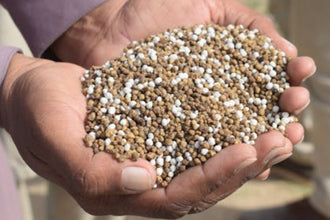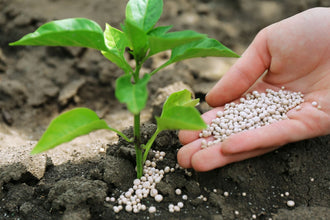
Fertilizer absorption happens through an amazing network of plant roots and soil chemistry that most gardeners never get to see. Your plants pull nutrients from the soil using specialized root structures and chemical processes that work around the clock. Understanding how this process works can completely change the way you feed your garden and help you make smarter choices about plant nutrition.
Most people think plants just suck up fertilizer like a straw draws water. The real story is far more complex and fascinating. Plants have developed incredible systems to capture, transport, and use nutrients from their environment. These systems involve everything from microscopic root hairs to beneficial soil bacteria that form partnerships with your plants.
The Root System: Your Plant's Nutrient Highway
Plant roots do much more than anchor your vegetables and flowers in place. They create an extensive underground network designed specifically for fertilizer absorption. The root system includes several key components that work together to gather nutrients from the surrounding soil.
Root hairs are tiny extensions that grow from the main roots. These microscopic structures increase the surface area available for nutrient uptake by up to 1000 times. A single grass plant can have millions of these root hairs working simultaneously to absorb fertilizer and water from the soil.
The root cap protects the growing tip as it pushes through soil particles. Behind this protective cap, the zone of elongation helps roots grow longer and reach new areas where nutrients might be available. This constant growth allows plants to explore more soil volume and find fresh sources of fertilizer.
Active vs Passive Nutrient Uptake
Plants use two main methods for fertilizer absorption: active transport and passive transport. Active transport requires energy from the plant to move nutrients against concentration gradients. This process allows plants to absorb nutrients even when soil concentrations are low.
Passive transport moves nutrients along concentration gradients without requiring plant energy. Water flow through the plant carries dissolved nutrients from areas of high concentration to areas of low concentration. Both processes work together to maximize fertilizer absorption efficiency.
The Role of Soil Chemistry in Absorption
Soil pH plays a huge part in determining how well plants can absorb fertilizer. Most nutrients become available to plants when soil pH stays between 6.0 and 7.0. Outside this range, many nutrients become chemically bound to soil particles and unavailable for plant uptake.
Cation exchange capacity describes the soil's ability to hold positively charged nutrients like calcium, magnesium, and potassium. Soils with higher cation exchange capacity can store more nutrients and release them gradually for fertilizer absorption. Clay soils typically have higher cation exchange capacity than sandy soils.
How Different Nutrients Enter Plants
Each nutrient type follows its own pathway for fertilizer absorption. Nitrogen, phosphorus, and potassium each have unique characteristics that affect how plants take them up from the soil.
Nitrogen moves through soil in several chemical forms. Nitrate nitrogen dissolves easily in water and moves freely through soil. Plants absorb nitrate quickly, but it can also leach away during heavy rains. Ammonium nitrogen sticks to soil particles more readily and provides a slower-release source for fertilizer absorption.
Phosphorus behaves very differently in soil compared to nitrogen. This nutrient binds tightly to soil particles and moves very slowly through the soil profile. Plants must grow their roots close to phosphorus sources for effective absorption. This explains why starter fertilizers often contain higher phosphorus levels to support early root development.

Potassium Movement and Plant Uptake
Potassium exists in soil in three main forms: solution potassium, exchangeable potassium, and fixed potassium. Solution potassium dissolves in soil water and provides immediate availability for fertilizer absorption. Exchangeable potassium attaches to soil particles but can be released as plants remove solution potassium from the soil.
Fixed potassium becomes trapped between clay mineral layers and releases very slowly over time. This form serves as a long-term potassium reserve but cannot support immediate plant needs during periods of rapid growth.
Micronutrient Absorption Patterns
Micronutrients like iron, zinc, and manganese follow different rules for fertilizer absorption. These nutrients often become less available as soil pH increases above 7.0. Iron deficiency commonly appears in alkaline soils even when iron levels are adequate because the iron becomes chemically unavailable to plants.
Chelated micronutrients use organic molecules to keep nutrients in forms that plants can absorb. These special fertilizer formulations help overcome soil chemistry problems that might otherwise prevent proper nutrient uptake.
The Symbiotic Relationship: Mycorrhizal Fungi and Fertilizer Absorption
Mycorrhizal fungi form beneficial partnerships with plant roots that dramatically improve fertilizer absorption. These fungi extend hair-like structures called hyphae far beyond the normal root zone. The expanded network can increase the effective root surface area by 100 to 1000 times.
The fungi receive carbohydrates from the plant in exchange for improved nutrient and water uptake. This partnership proves especially valuable for phosphorus absorption because the fungi can access phosphorus sources that roots cannot reach on their own.
Different plant families prefer different types of mycorrhizal fungi. Most vegetables and annual flowers work with arbuscular mycorrhizal fungi. Trees and shrubs often partner with ectomycorrhizal fungi. Understanding these relationships can help you choose fertilizers that support both plants and their fungal partners.
Soil Biology and Nutrient Cycling
Beneficial soil bacteria also play important roles in fertilizer absorption. Some bacteria can fix atmospheric nitrogen and make it available to plants. Others help break down organic matter and release nutrients in forms that plants can use.
Soil organisms create a complex web of nutrient cycling that extends far beyond simple fertilizer absorption. Organic matter decomposition, mineral weathering, and biological nitrogen fixation all contribute to plant nutrition. Healthy soil biology often reduces the need for synthetic fertilizers by improving natural nutrient availability.
Timing and Environmental Factors
Temperature affects every aspect of fertilizer absorption. Cool soils slow down root activity and reduce nutrient uptake rates. Most plants absorb nutrients most efficiently when soil temperatures stay between 65 and 85 degrees Fahrenheit.
Soil moisture levels must stay within the right range for optimal fertilizer absorption. Dry soils prevent nutrients from dissolving and moving to root surfaces. Waterlogged soils reduce oxygen availability and slow root metabolism. The sweet spot provides adequate moisture without creating oxygen-depleted conditions.
Light levels influence fertilizer absorption indirectly through their effects on plant metabolism. Plants growing in bright light have higher energy levels and can support more active nutrient transport. Shade-stressed plants often show reduced ability to absorb and use nutrients effectively.
Seasonal Patterns in Nutrient Uptake
Plants change their fertilizer absorption patterns throughout the growing season. Early season growth focuses on nitrogen uptake to support leaf and stem development. Mid-season plants increase phosphorus and potassium absorption to support flowering and fruit development.
Late season nutrient needs shift toward potassium and micronutrients that improve plant stress tolerance and help prepare for winter dormancy. Understanding these seasonal patterns helps gardeners time fertilizer applications for maximum effectiveness.
Maximizing Fertilizer Absorption in Your Garden
Several practical strategies can improve fertilizer absorption in your garden. Maintaining proper soil pH creates the foundation for good nutrient availability. Regular soil testing helps identify pH problems before they limit plant growth.
Adding organic matter improves both soil chemistry and biology in ways that support better fertilizer absorption. Compost, aged manure, and other organic amendments increase cation exchange capacity while feeding beneficial soil organisms.
Proper watering practices keep nutrients mobile in the soil solution where roots can absorb them. Deep, infrequent watering encourages root growth into deeper soil layers where nutrients may be more abundant.
Transform Your Garden with Better Nutrient Understanding
Understanding fertilizer absorption gives you the knowledge to make smarter gardening decisions. Plants work hard to gather nutrients from their environment using sophisticated biological and chemical processes. Supporting these natural systems creates healthier plants and more productive gardens.
The science behind nutrient uptake shows why soil health matters just as much as fertilizer application. Building better soil biology, maintaining proper pH, and timing nutrient applications all contribute to improved fertilizer absorption and plant performance.
Ready to put this science to work in your garden? Fancy Chicken organic fertilizer works with your soil's natural processes to support healthy nutrient cycling and optimal plant growth. Our balanced 4-2.5-2 formula feeds your plants while building the soil biology that makes fertilizer absorption more efficient season after season.








